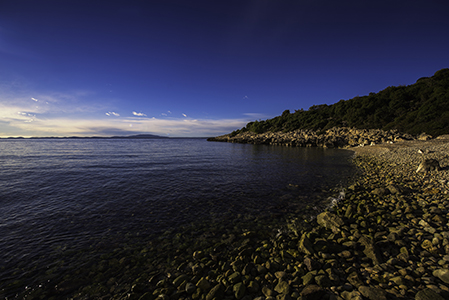The Olive Gardens of Lun
The Olive Gardens of Lun are located on the northern shores of Pag Island. The remote settlement of Lun was founded in 1653.
But nations of the ‘Old World’ harvested local olive groves and enjoined prime taste of their golden-colored oil long time before.
Scientists have confirmed, that at least one thousand of the olive trees, are more than a millennium old, meaning they sprouted during the times of kings and knights. One particular olive tree is 1600 years old. Only two similar natural sites exist in the world. One in Israel, while the other is in Greece.

The size of the Olive Gardens of Lun is around 500 hectares and count more than 80 000 olive trees today.
It is a slightly elevated rocky terrain spanning down to the coast and on the way to the shore, one is crossing through a web of dry-stone-walls. You can see small sheep herds and nothing disturbs the silence except the sound of the sea.
More about Olives (Olea europaea)
Biologically olives belong to the stone fruit family and are related to mangoes, cherries, peaches, almonds, and pistachios. They are very high in vitamin E and other powerful antioxidants.
Throughout the growth stages of the olive fruits they change the color. You can pick olives at various stages of their maturing process, starting from late summer until autumn. At the beginning of the harvest the olives are green and taste different compared to the olives, picked later in the season from the same tree. The riper the fruit, the darker it becomes in color.
The flavor of a green olive is nutty, and the fruit is firm. The darker and wrinkled an olive becomes, the taste is more intensive.
How to prepare fresh Olives from the Garden?
One method, which derives from Greece, is a small cut into the olives’ skin and soak them for 4 weeks in cold water. The water is to change daily.
Why change the water so often? Well, if you’ve ever bitten into a fresh olive, you know it. Olives are full of bitter substances that needs to be leached out. Opening the olive allows the bitterness to dissolve into the water. That’s why you need to change the water once a day to maximize the leaching process. Store them during the process outside when it’s cold already or in the fridge.
Put the olives in a bowl and keep them submerged to avoid oxidation. It helps to use a deep plate as a weight to force them to stay submerged.
After the 4 weeks leaching process with water, the olives are stored now in brine. The brine is made of a 1/4 cup salt to 4 cups cold water. For the taste you add white wine vinegar, oregano, lemon, and garlic to the olives. It is mandatory, that the liquid level of the brine is always sufficient, to cover the olives completely.
To see the beautiful Olive Gardens of Lun with your own Lens, book your tailor made photo tour Croatia with me.
Best wishes and stay fascinated.
Yours, Sandra Sachsenhauser


